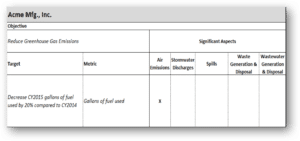By Cory Sander
Objectives and targets are a critical part of any Environmental Management System or EHS plan, but it can be tricky to use these two powerful tools effectively. Luckily, we have a few tips, tricks and tactics to help you set strong EHS objectives and targets.
For starters, let’s make sure we understand exactly what the words objective and target mean. ISO 14001 defines an objective as an “overall environmental goal, consistent with the environmental policy, that an organization sets itself to achieve.” For a target, ISO 14001 says it’s a “detailed performance requirement, applicable to the organization or part thereof, that arises from the environmental objectives and that needs to be set and met in order to achieve those objectives.”
Wait, what? No wonder there’s a little confusion. In layman’s terms, an objective is the overall environmental change your organization wants to achieve, and a target is the measurable outcome of the change. Let’s use the beginning of a family vacation as an analogy. Your main overall change is to get from point A to point B, so that’s your objective. What might be a measurable outcome of your objective? Travel time measured in hours and minutes—9 hours, 15 minutes to Walley World. That’s your target.
It’s a Team Effort
Developing objectives and targets for your EHS plan is an iterative and lengthy process. It starts with your core EHS team then gets shared with a larger advisory team crossing all affected departments, and finally, a management or steering team. Think draft, review, modify and finalize. All along the way you’ll consult with people across your organization and gather key data.
Writing your objectives and targets down is a must—either in a PowerPoint or Word document or logging them in your EHS software. They should be consistent with your organization’s overall environmental policy and directly relate to your documented requirements. Look for ways to reduce environmental impacts and focus on continual improvement. As you’re working, consider technology options, financial, operational and business requirements, and views of interested parties.
Are They Strong or Weak?
Once you’ve written down your objectives and targets, you’ll want to check and make sure they’re all strong enough to earn a spot in your EHS management plan. Strong objectives link directly to significant aspects and impacts, focus on the big picture and relate to a desired environmental change. They’re also brief, clear and concise. Strong targets link directly to objectives. They’re also measurable and include baselines. Here are two examples:
Strong EHS Plan Objective and Targets


You can spot weak objectives and targets by what they’re not. A weak objective isn’t linked to significant aspects and impacts. It’s too detailed or wordy and too task related. Plus, there’s no direct environmental connection. A weak target isn’t linked to an objective, and it’s not task-related. You’d have a tough time measuring it, and there’s no baseline. Here are two examples of what not to do:
Weak EHS Plan Objective and Targets


Helpful Hints for Success
You’ve got the basics down, but it can still be tricky to put it all together. Here’s a list of my favorite tips and tricks for creating strong and effective objectives and targets:
- Create them along with other major planning processes, such as budgeting.
- Correlate your objectives and targets to your environmental policy, as well as significant aspects and impacts.
- Ask peers at other companies for advice or search the internet.
- Understand your team and organization’s limitations, so you don’t over commit.
- Create them once quickly with the first things that come to mind. Then review, analyze, discuss and modify.
- Identify multiple potential objectives and targets for significant aspects and impacts.
- Review and update them on a monthly basis, adjusting as needed and documenting why.
You’ll never completely be done with your objectives and targets, but following some of the advice above can start you off on the strongest foot possible.
